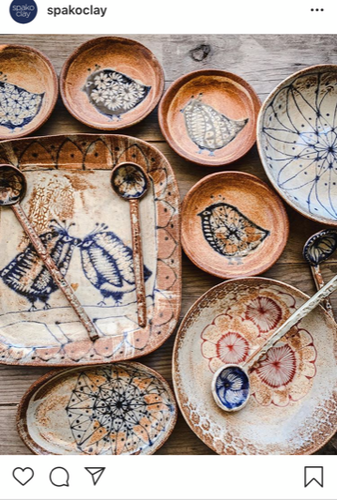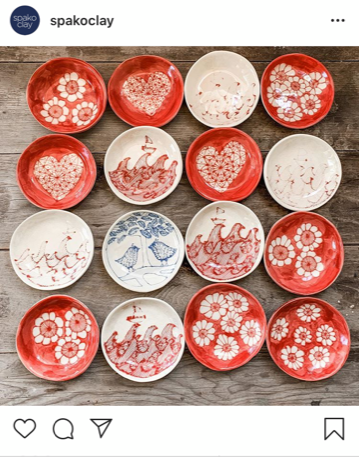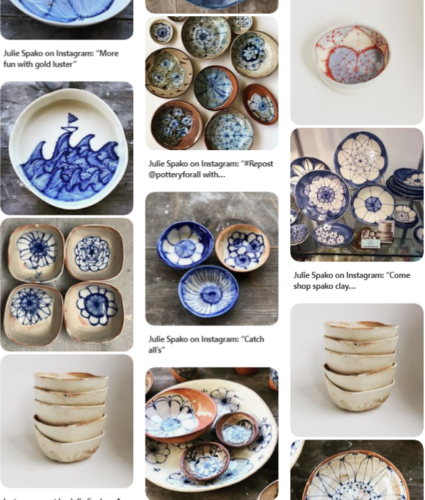by Carolyn Edlund
How did ceramic artist Julie Spako attract more than 80,000 followers and make daily sales on Instagram?

Julie Spako’s Instagram feed is filled with groupings of her appealing and collectible work.
Austin, Texas-based potter Julie Spako has managed to amass a huge following on Instagram, which continues to grow. Known as the best social media platform for selling art, her Instagram feed has provided her a steady stream of sales and inquiries. By cross-posting her images to Pinterest, she’s gained even more traction, with more than 164,000 monthly viewers.
Spako runs a production ceramic studio and primarily sells her pottery wholesale to retailers across the U.S. Her line consists mostly of tableware with charming hand-painted designs that are almost compulsively collectible.
Her first efforts on social media weren’t geared towards building a big online presence, or even making sales. “I started on Instagram as a way to share what I was working on with my friends from my pottery class. I was shy at first about what I thought as ‘advertising’ my work, but it was fun to share with people I knew,” she says.
In fact, Spako didn’t even have a website when she began using Instagram back in 2015. A friend bought her a domain name for her birthday, which was directed at first to her Instagram feed. But when she made the decision to launch a full-time studio business, she built a site on Squarespace to share her collection.

Spako photographs her work on an old work table, which adds the perfect rustic touch.
Building a Brand
In 2017, the artist exhibited at the Dallas Market Center Home and Gift Show, a wholesale marketplace. She recalls, “At the show, shop owners asked about Instagram. One person asked how many followers I had. When I told her, she replied that she thought I would have more. I realized a presence on Instagram was important to building my brand.”
Spako was on Instagram for about two years before getting real traction. At that point, she committed to taking a photograph every time her kiln was unloaded. She shoots a grouping of her pottery placed on a weathered old table that provides a perfect rustic background. “Photographing my work means I have images to distribute,” she says. Although I’m a potter, images sell my pieces. To me, they go hand in hand. My photo area is set up on the patio, and don’t use any fancy props or lightboxes.”
One of her images was picked up by a highly popular Instagram feed that features ceramics, resulting in a huge increase in followers and engagement. Hoping to be featured there again, Spako reached out to the profile owner, who had started charging for posts. She agreed, and built that cost into her marketing budget.
Then, she learned to use hashtags. “It’s an important part of getting new followers. Study popular sites in your field, and see which hashtags they list. Select ones you want to use, and update from time to time,” she advises. “Hashtags have helped get my brand in front of a massive audience. Every single day I have people inquiring about how and where to buy my pieces.”

Potter Julie Spako cross-posts her Instagram feed to Pinterest for more exposure.
Her Strategy
The artist considers Instagram to be an effective online visual catalog of her work. But when traffic to her Instagram account slowed, she found that cross-posting to Pinterest helped introduce new people to build her following.
Spako posts between one and five photographs of her work every week on Instagram, and then on Pinterest. She recommends that for both, it is best to have a (free) professional account, which is easy to set up. “You don’t need to know a bunch of secrets or SEO or algorithms,” she explains, “The results are not instantaneous, but they are consistent. Using more than one social platform has helped generate interest in my work across media.”
An added benefit with Pinterest is that the artist now has more control over her narrative. “Anybody can pin my images to Pinterest, but now I can list correct data, like my website and how to order,” Spako says. “I noticed some pins would say that work was out of stock or no longer available, when neither was true, and the link was broken.” She resolved the issue by taking five minutes a day to pin photos of her work with hashtags and a description. That effort drives traffic to her website, and adds subscribers to her email list.
Additionally, she has started using “promoted pins.” for $1 a day for 30 days, she promotes one pin. She has found that this increases impressions by 87%, audience by 101%, and engagements by 91%.
“The tools that I use are (mostly) free and easy to do with a smartphone,” she says. “I encourage artists to try these methods to develop an online presence that exposes their work to a large number of people. Through my use of Instagram and now Pinterest, I have been able to create a vast interest in my work and generate income.”


FANTASTIC!
THANK YOU FOR SHARING…
thanks for this. I will try the Pinterest $1 ads. never thought about doing that
Great article!
I’m on IG and will set up a page on Pinterest.
I’d love to know how these marketing tools have
affected your sales.